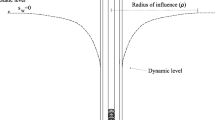Conclusions
-
1.
The errors associated with the method of solving seepage problems with consideration of the slope of the aquiclude are determined by the form of the boundary conditions, degree and form of nonlinearity of the process, and its duration.
-
2.
When solving problems under conditions of pronounced nonlinearity of unsteady seepage, when the required accuracy permits using the piezometric head as the potential function (ϕ=H), the method of solution on capacitance models is the most expedient owing to its sufficiently high accuracy and considerably less laboriousness in comparison with the Liebmann scheme.
-
3.
If the required accuracy of forecasting necessitates solving the nonlinear problem in potential functionsϕ=h, then it is expedient to use the R-R model according to the fractional step scheme. It should be noted that for two-dimensional problems with a large number of nodes the given scheme requires a considerable number of calculations, and, therefore, when solving such problems it is advisable to be oriented to modeling of flow channels (singled out on the basis of the principle of their nondeformability); if necessary the configurations of the flow channels can be refined while solving the problem.
-
4.
The use of current conductors for solving nonlinear problems (with iterations) gives unsatisfactory results.
Similar content being viewed by others
Literature cited
I. E. Zhernov and V. M. Shestakov, Modeling of Groundwater Seepage [in Russian], Nedra, Moscow (1971).
A. A. Samarskii, Introduction to the Theory of Difference Schemes [in Russian], Nauka, Moscow (1971).
L. L. Bokii and Yu. A. Norvatov, “Solution of problems of nonlinear unsteady seepage on network models,” in: Trans. of the Joint Conf. on Hydr. Eng. [in Russian], No. 93, Énergiya, Leningrad (1974).
I. I. Krashin, V. V. Ganyavin, and E. K. Orfanidi, Modeling of Processes of Heat and Mass Transport in Groundwater [in Russian], VSEGINGEO, Moscow (1974).
A. G. Aleksandrov, V. I. Bartel'skii, V. G. Nasonov, and I. A. Sorokina, “Method of solving problems of groundwater seepage on an inclined aquiclude by modeling,” Tashkent. Gos. Univ., No. 424 (1972).
W. W. Soroka, Analog Methods in Computation and Simulation, No. 7, McGraw-Hill (1959).
D. Mollov, “Electrical modeling of groundwater flow on an inclined aquiclude,” Dokl. Bolgar. Akad. Nauk,23, No. 3 (1970).
N. N. Yanenko, Method of Fractional Steps for Solving Multidimensional Problems of Mathematical Physics [in Russian], Nauka, Moscow (1967).
Additional information
Translated from Gidrotekhnicheskoe Stroitel'stvo, No. 1, pp. 23–26, January, 1979.
Rights and permissions
About this article
Cite this article
Norvatov, Y.A., Bokii, L.L. Method for electrical modeling of unsteady seepage on an inclined aquiclude. Hydrotechnical Construction 13, 37–41 (1979). https://doi.org/10.1007/BF02304310
Issue Date:
DOI: https://doi.org/10.1007/BF02304310




